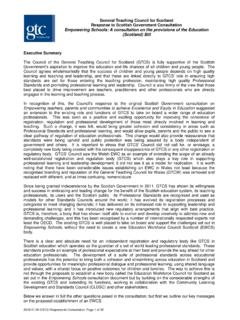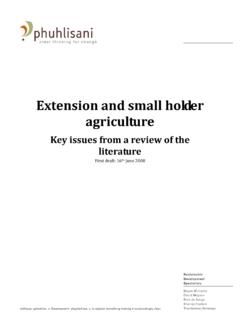Transcription of Families are changing - OECD.org
1 Doing Better for Families OECD 201117 Chapter 1 Families are changingFamilies have changed over the past thirty years. This chapter provides an overviewof the changes in family formation, household structure, work-life balance, and childwell-being. Fertility rates have been persistently low in many OECD countriesleading to smaller Families . With marriage rates down and divorce rates up, thereare an increasing number of children growing up in sole-parent or reconstitutedfamilies. Sole-parent Families are of particular concern due to the high incidence ofpoverty among such risks are highest in jobless Families and lowest amongst dual-earnerfamilies. Important gains in female educational attainment and investment in morefamily-friendly policies have contributed to a rise in female and maternalemployment, but long-standing differences in gender outcomes in the labour marketstill persist. The increased labour market participation of mothers has had only alimited effect on the relative child poverty rate as households without children havemade even larger income well-being indicators have moved in different directions: average familyincomes have risen but child poverty rates are also up.
2 More youngsters are now inemployment or education than before, while evidence on health outcomes is , are Families doing better? Some undoubtedly are, but many others faceserious constraints when trying to reconcile work and family Families ARE CHANGINGDOING BETTER FOR Families OECD 201118 IntroductionFamilies are changing in many ways across the OECD and its enhanced-engagementpartners. Most countries have seen a decline in the fertility rate over the past threedecades. Today almost no OECD country has a total fertility rate above the populationreplacement rate of two children per women. As a result the average household size hasalso declined over this period. At the same time, there has been a sharp increase in theproportion of women entering the labour force. The evidence on trends in child well-beingis mixed, and important challenges remain. There are still large gender gaps inemployment and earnings and one in eight children, on average across the OECD, still livesin relative formation patterns are also changing .
3 Increasingly, both men and women wantto first establish themselves in the labour market before founding a family. Hence, the ageof mothers at first childbirth has risen and with it the probability of having fewer childrenthan previous generations. Many women remain childless. Birth rates have fallen and lifeexpectancy has increased, so there are fewer children and more grandparents than , Panel A and Panel B illustrates how birth rates and average household sizes havefallen in most OECD countries since the educational attainment and female employment participation (Figure ,Panel C) have both risen over the last 30 years. Women have a better chance of fulfillingtheir labour market aspirations and much needed additional labour supply has beenmobilised. And while increased maternal employment has contributed to material wealthamong Families with children, comparable societal groups without children have also seensimilar gains.
4 Poverty rates among households with children, based on a relative povertyconcept related to half of equivalised median household income, have increased slightlyacross the OECD over the past 10 years (Figure , Panel D).Issues in family policy, underlying policy objectives and evidence on good practiceswill be discussed in subsequent chapters. This chapter outlines some of the key indicatorsthat illustrate modern family life and how these affect the well-being of children andparents across the OECD countries and its enhanced engagement The secondsection provides an overview of the change in family formation over the past thirty years,while the following section illustrates changes in household structure and changes inparent-parent and parent-child relationships. The next section focuses on employmentoutcomes for parents and what effect this may have on family poverty risks. Beforesummarising the overall family outcomes, the final section considers child well-beingagainst three key dimensions of material, education and health in fertility and family formationIn many OECD countries, policy makers are increasingly concerned about adults beingable to have as many children as they desire.
5 Fertility behaviour can be constrained fordifferent reasons: the perceived inability to match work and care commitments because of1. Families ARE CHANGINGDOING BETTER FOR Families OECD 201119 Figure are changingNote:Panel B: Data missing for Estonia, Israel and Data refers to 2007 for Canada; 2008 for Brazil, Chile, China, India and Indonesia. 2. The size of households is determined by memberswho live in the same dwelling and include dependent children of all ages. 3. Data refers to 2003 for Brazil; 2007 for India and South Poverty thresholds are set at 50% of the equivalised median household income of the entire population. 5. Data refers to 2008 forGermany, Israel, Italy, Korea, Mexico, Netherlands, New Zealand, Norway, Sweden and the United States; 2007 for Canada, Denmark andHungary; 2006 for Chile, Estonia, Japan and Slovenia; 2005 for France, Ireland, Switzerland and the United Kingdom; 2004 for Australia, Austria,Belgium, Czech Republic, Finland, Greece, Iceland, Luxembourg, Poland, Portugal, the Slovak Republic, Spain and :OECD (2010b), OECD Employment Outlook; Provisional data from OECD (2010e), Income Distribution Questionnaires; United NationsStatistical Division, 2010; UNECE, 2010; and national statistical offices, 2 07.
6 27. A. Total fertility rates, 1980 and 20091 Panel B. Average household size,2 mid-1980s and mid-2000s320091980 Mid-1980sMid-2000sRussian FederationChinaBrazilIndonesiaSouth AfricaIndiaKoreaPortugalHungaryGermanyJa panAustriaPolandSpainItalySlovak RepublicCzech RepublicSwitzerlandGreeceSloveniaLuxembo urgEstoniaCanadaOECD34 averageOECD34 averageOECD31 averageOECD34 averageNetherlandsBelgiumDenmarkFinlandA ustraliaSwedenUnited KingdomNorwayFranceChileUnited StatesIrelandMexicoTurkeyNew ZealandIcelandIsraelChildren per womanNumber of persons in householdRussian FederationBrazilSouth AfricaIndiaSwedenGermanyUnited KingdomDenmarkFinlandNorwaySwitzerlandNe therlandsBelgiumAustriaFranceCanadaLuxem bourgCzech RepublicHungaryAustraliaIcelandUnited StatesItalyNew ZealandJapanGreecePortugalSpainPolandIre landSlovak RepublicKoreaChileMexicoTurkeyPanel C. Proportion of women (aged 15-64) in the labour market, 1995 and 2009 Panel D. Proportion of children in poor households,4mid-1990s and mid- to late-2000s520091995 Mid-1990sMid/late-2000s% of female population% children aged < 18 IndiaSouth AfricaIndonesiaBrazilRussian FederationChinaTurkeyChileMexicoItalyGre eceHungaryKoreaPolandSlovak RepublicSpainIsraelBelgiumCzech RepublicLuxembourgIrelandJapanFrancePort ugalEstoniaUnited StatesSloveniaGermanyUnited KingdomAustraliaAustriaNew ZealandFinlandCanadaSwedenNetherlandsDen markSwitzerlandNorwayIcelandRussian FederationDenmarkFinlandNorwayAustriaSwe denHungarySloveniaFranceIcelandGermanySw itzerlandNetherlandsBelgiumUnited KingdomKoreaCzech RepublicSlovak RepublicAustraliaNew ZealandEstoniaLuxembourgGreeceJapanCanad aItalyIrelandPortugalSpainChilePolandUni ted StatesTurkeyMexicoIsraelReplacement rate = Families ARE CHANGINGDOING BETTER FOR Families OECD 201120inflexible labour markets and/or the lack of public supports, the financial costs of raisingchildren.
7 And the difficulty for prospective parents in finding affordable housing toestablish a family of their own. This section illustrates the main drivers of trends in familyformation and how they vary between OECD countries. The restrictions to familyformation and related public policy issues are discussed in Chapter patternsDemographic trends involve low and/or declining fertility rates and increasing lifeexpectancy in most OECD countries (OECD, 2010a, ). The resultant ageing populationshave led to a decline in the number of women of childbearing ages, and curtailed growth ofthe potential labour force. In some countries this has already resulted in a sharp decline ofthe working-age population, as seen in the Russian Federation (OECD, 2011a). The growingnumber of retirees will lead to higher public (and private) spending on pensions and long-term care supports for the retired population (OECD, 2010b and 2011b).
8 Informal supportnetworks will come under increasing pressure as the declining number of children willlead to a reduction of future informal carers for the elderly fertility rates (TFR) among the OECD countries have declined dramatically overthe past few decades, falling from an average of children per woman in 1970 to justover in 2009 (Figure , Panel A). The average TFR across the OECD bottomed out children per woman in 2002 and has since edged up. Overall, the average TFR across theOECD has been below replacement level since In 2009, the TFR was around thereplacement rate in Ireland, Mexico, Turkey and New Zealand, and it was abovereplacement level in Iceland ( ) and Israel ( ). Historically, the fertility rates wereextremely high in all enhanced engagement countries, except for the Russian Federation,with TFRs greater than children per woman in the early 1970s.
9 Since then there hasbeen a steady decrease in Brazil, India, Indonesia and South Africa, with the TFR droppingbelow 3 children per women in all four countries in recent years. In China, where fertilityrates were also high, around in the early 1970s, there was a large decrease in thelate 1970s, and, following the introduction of the one-child policy, the TFR fellto in 1979. Since then there has been a continuous drop for the past few decades andthe TFR in China currently stands below the replacement level at around at children perwoman (Figure , Panel B).The pace of decline in TFR varied widely between countries. In northern Europeancountries, the decline started early but has oscillated around children per womensince the mid-1970s. By contrast, among southern European countries the decline hasbeen slower, starting in the mid-1970s, but reached an extremely low level of in 1994before slowly starting to edge up.
10 Fertility rates in Japan and Korea (OECD, 2007a)were in decline until 2005. In contrast fertility rates in the United States bottomed inthe mid-1970s, and have oscillated around two children per women for the past 20 the Russian Federation, the fertility rates were more stable than in OECD countriesin the 1970s, followed by a rise in the 1980s peaking at children per woman in growth was followed by a sharp decline throughout the 1990s, reaching a lowof in the long period of decline, fertility rates began to rise from 2002. Since 2002the TFR has increased by children per woman in Australia, Belgium, Denmark, Greece,Iceland, Italy, Norway, Poland and Spain; and by children per women in theCzech Republic, New Zealand, Sweden and the United Kingdom up to 2008 (OECD, 2010a,1. Families ARE CHANGINGDOING BETTER FOR Families OECD ). Thus, there appears to have been a rebound in fertility in Nordic countries withfertility rates relatively close to the replacement level, and also in some of the so-called lowest-low fertility rate countries in southern Europe and the Czech Republic wherefertility rates had bottomed around children per women.

















